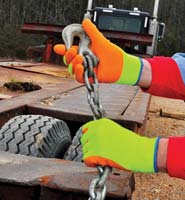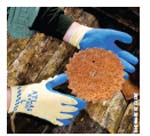
Don't Let Carelessness Put Construction Site Hands at Risk
Wearing gloves reduces the relative risk of hand injury for construction workers by as much as 60 percent
- By Donald F. Groce
- Apr 01, 2009
 Look around a construction site: Just how many workers are barehanded? Statistics show the percentage of injuries involving lacerations is considerably higher for the construction industry than for all other industries. And yet, despite the availability of comfortable, cut-resistant gloves, it is not unusual for most construction workers to go gloveless for at least part of the work day.
Look around a construction site: Just how many workers are barehanded? Statistics show the percentage of injuries involving lacerations is considerably higher for the construction industry than for all other industries. And yet, despite the availability of comfortable, cut-resistant gloves, it is not unusual for most construction workers to go gloveless for at least part of the work day.
The danger of going gloveless on the construction site is borne out by a study conducted by Welch et al. and funded by the Center for Construction Research and Training (CPWR), which tabulated the causes of nonfatal injuries among construction workers who were seen at the George Washington University Emergency Department during a seven-year period. The leading cause of injury was contact with cutting or piercing objects—most often, pieces of metal, razors and knives, power tools, and nails. Fingers and hand injuries were the most-often-injured body parts among the construction workers, accounting for one-third of emergency room visits.
While conceding that wearing abrasion- and laceration- resistant gloves will not protect against every potential hand injury, officials such as ISEA President Dan Shipp point out that data suggest road construction companies are spending a whole lot more to cover the costs of hand injuries each year than they would pay to equip their workers properly and make sure they are wearing their gloves when they need them. It is generally believed that wearing gloves reduces the relative risk of hand injury for construction workers by as much as 60 percent.
Lacerations Not the Only Risk
But laceration is not the only hand injury risk to construction workers. Chemicals found in common building materials, such as Portland cement, also pose risks to workers' hands. Chemical hazards to constructions workers' hands have been around for decades but are just now coming to the forefront of concern.
Hexavalent chromium is a major concern in the construction trade, especially for workers using Portland cement, because it has been proven to cause lung cancer in humans. It is generated from oxidation of trivalent chromium in cement kilns. Workers are then exposed by breathing cement dust or handling wet cement. Wet cement contains traces of hexavalent chromium, a potent skin sensitizer that causes dermatitis and debilitating chemical sensitization in workers whose skin is exposed to it.
More than 1.3 million workers in the construction trade are exposed to Portland cement and thousands more to cement dust. Skin conditions in the masonry industry are 2.5 times the national average. A study by EPA and Johns Hopkins showed a very strong dose-response relationship for chromate exposure and the development of lung cancer. Another study by Mancuso showed that 23.3 percent, or almost one fourth, of the deaths of workers in a chromate plant since 1951 were from lung cancer.
Construction workers must be provided with and use the proper Personal Protective Equipment (PPE), including respirators or masks for fumes or cement dust that may contain hexavalent chromium and chemical- resistant gloves and garments that protect from exposure to wet cement and prevent contact sensitization. Common cotton and leather gloves or partially coated gloves offer little to no protection from wet cement. Chemical-resistant gloves should always be used for handling wet cement. Chemical-resistant gloves are fully coated with a chemical-resistant polymer coating such as Nitrile, Neoprene, or PVC. These materials offer excellent protection from caustic and hexavalent chromium-containing wet cement.
Better Glove Options
Recent developments in glove manufacturing have made wearing gloves that protect against lacerations and/or chemicals such as hexavalent chromium more attractive. Traditional bulky leather and polymer workhorse gloves are being replaced by a new generation of lighter-weight, ergonomically designed gloves that are more accepted by workers. Workers find flat-dipped, lightly coated gloves much more comfortable and attractive because of their dexterity, which cuts down on hand fatigue. Still long wearing, today's lighter-weight gloves encourage continual wear by the worker and wear for a broad range of uses.
Continuous Wear: Although lighter, coated, thinner knit gloves are not as cut resistant as the heavier thicker knit gloves, they are more easily worn for a variety of tasks where workers previously may have shed gloves to gain the touch sensitivity and dexterity needed to perform a task.Gloves coated with Natural Rubber, Nitrile, PVC, or Polyurethane are gaining wider acceptance for a variety of tasks in the construction industry because they are easier to work in and will therefore be worn longer.
Oily Grip: Foam or sponge Nitrile gloves are used in this industry because they feature a porous polymer coating that has the ability to grip an oily, slippery object, helping workers avoid dropping objects that could cause injury to the hands or other body parts. Some multi-functional gloves offer the benefits of the powerful gripping action of sponge Nitrile coatings plus high-visibility liners that enhance safety in construction applications where high visibility is essential to worker safety.
Cut Resistance: Gloves that offer sponge Nitrile coatings with a cut-resistant liner of yarns such as Kevlar® or High Performance Polyethylene (HPPE) offer both oily grip and cut resistance. These gloves are ideal for handling sheet metal or other materials that present multiple hazards. Protecting from lacerations while providing enhanced gripping action serves a dual purpose that is mutually beneficial to both the worker and the employer.
High Performance fibers such as HPPE can be made even stronger by wrapping with stainless steel or fiberglass yarn for the highest cut resistance available. There is no cutresistant glove that works for moving or serrated blades. Cut resistance is normally measured using a blade that is similar to a razor blade. Moving blades will cut through a cut-resistant glove and should be avoided using engineering controls. Serrated blades can get caught in the knit material used in cut-resistant gloves and cut through them.
Durability: Durability or length of wear of polymeric materials can be two to 10 times longer for gloves that are coated with Natural Rubber, Nitrile, or PVC compared to leather and cotton gloves. Some flatdipped gloves even have an extra layer of polymer in the areas of the glove that wear the most: the thumb crotch between the thumb and first finger. Polyurethane-coated nylon or HPPE gloves offering a very durable, long-wearing coating are super lightweight and comfortable.
No Excuses for Barehanded Workers
With all of the new developments in glove technology, lack of dexterity or cumbersomeness is not a valid excuse for not wearing gloves. The flat-dipped technology used to make many of the polymercoated gloves provides a much cooler glove so that workers do not get so hot that they take off their gloves.
Reducing hand injuries in the construction industry is everyone's job. With all of the hand protection products available in the marketplace designed to enhance safety, comfort, and worker acceptance, the only missing ingredients are training and enforcement. Employers must provide the training for employees, especially for transient jobs they are not used to doing. The workers must be trained on the risks associated with the jobs they are performing and the proper PPE to help reduce those risks. For their part, construction industry management must enforce the "gloves on" policy.
This article originally appeared in the April 2009 issue of Occupational Health & Safety.